Samsung D780 review: Dual SIMplicity
Dual SIMplicity
Dual SIM functionality
The pivotal feature of Samsung D780 is indeed the dual SIM capability. It is important to note that even though the two SIM cards are active simultaneously, there are still some limitations.
It starts with the master and slave SIM card hierarchy. The master SIM is the default (primary) one used for calls, messaging, GPRS/EDGE, etc, while the slave card has calls and SMS capability only. Of course, the master and slave cards can be swapped with a flick of a system setting, but in this case a reboot is required.
The crucial aspect of this subordination is the frequency band limitation - only the master SIM card has tri-band GSM support. The transceiver responsible for the slave SIM is a dual-band one only - that makes the dual SIM functionality unusable in countries that use the 1900 Mhz band such as North America.
When you insert one or two new SIM cards in Samsung D780, you need to assign them names and priority to get started. Once you are done, you can start reaping the dual SIM benefits. If you need to make changes to that setup later, you can open the simple SIM management interface by pressing the dedicated key on the handset's left side. The interface is accessible from the Settings menu too.
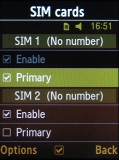
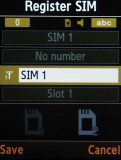
Registering your SIM card: setting name and priority • SIM card management
The SIM management interface is rather simple, allowing the user to set the primary card, and to name or enable/disable one or both cards. While the enable/disable option is a matter of mere seconds, changing the primary and secondary card requires a restart of the phone.
Call management, phonebook and messaging specifics
When you want to call somebody, all you need is type or scroll the phone number and then choose which card to use for the outgoing call. The primary SIM is default and pressing the call key directly dials the number using it.
However, if you wish to call using the secondary SIM card, pressing the dedicated SIM management key switches the SIM card for the outgoing call. There are no delays or glitches whatsoever using this feature. We are particularly pleased with the Samsung implementation of this interface.
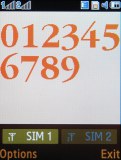

Toggling SIM card tabs at the bottom of the screen
Upon an incoming call the caller number/name is accompanied by the name of the SIM card which is receiving the call.


Dexter calling on SIM2 • the missed call notification shows SIM too
The Call log is also very well geared to accommodate the dual SIM functionality. It displays the type of call (incoming, outgoing, etc.), the SIM card, the caller number/name and the number of calls. When you select a log entry, you can see the entire call history, including the time and date, the SIM card again and the call duration. You can opt to return the call using the default SIM card or the secondary one.
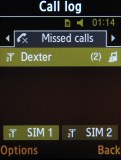
Calls log displays the SIM card used
A new number can easily be saved in either the phone memory or on one of the two SIM cards. In contacts, there are tabbed menus, which are shortcuts to the Groups, FDN (frequently dialed numbers), SIM 1 and SIM 2. So, if you rarely use the SIM contacts, it is better to set the phone memory view option, yet the SIM contacts remain at hand.
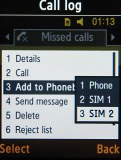
Choosing where to save a new number
The phonebook itself displays the name, the default number (when a name is highlighted) and the memory used for contact storage - an icon to the right for SIM 1 and SIM 2 designates where the contact is stored.
Composing a new message doesn't differ from any other Samsung phone and is much like making a call. If a message is sent straight away it goes through the primary SIM card. However with a single press of the dual SIM key, you can channel it through the secondary SIM.
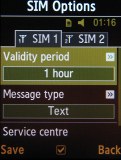

There are separate message options for the two SIM cards • sending message allows you to change SIM cards
So, that's about all there is to know about call and message management in a dual SIM scenario. Again, as we already said in the beginning of this review, bear in mind that there are certain limitations to the technology, too. You can only use the primary SIM card for GPRS/EDGE connectivity and it's only the primary SIM card that benefits from tri-band connectivity. The secondary SIM card works in dual-band mode only.
Final words
Samsung D780 is a well balanced phone for the mass user and the dual SIM action is truly an ace up its sleeve. The lack of 3G support and the poor music player and web browser are the main drawbacks - we've already been there with Samsung D880 Duos. Again much like the D880 Duos, the Samsung D780 packs an excellent camera and a rather large body. Having mentioned it, Samsung D780 brings nothing we didn't see in the Duos, except for the different form factor.
Anyway, the appeal of Samsung D780 is not skin deep. It may only play one song, but it plays it right, and in a market niche wide open it just can't be a one hit wonder. After all, it takes a few tries like D780 before we move on to dual SIM Ultra handsets and dual SIM smartphones.
Reader comments
- AnonD-478309
- 19 Dec 2015
- IEt
Can someone help ? I have an LG dare and my fiancé has a Samsung D780. I have tried sending photos to her as well as she has tried to send to me. It wont allow this, can anyone help, is there a setting that needs to be changed. She has a 100 p...
- D.R.Duggal
- 13 Aug 2015
- rJ9
It is one of my favorite phones...I bought D780 in 2010 it is still working at satisfactory label...only problem is its body panel is no available...i need it desperately...anybody plz help
- santosh
- 26 Dec 2014
- rA%
Sim2 No network